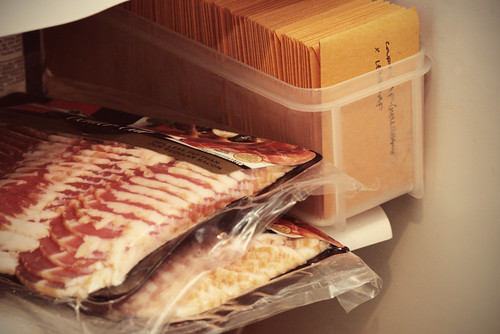Hope everyone had an awesome New Year! 2011 is now here! YEAH!
2011. Amazing to think how fast time goes by. Wasn’t it only yesterday that we were worried about that whole Y2K thing? And, oh yeah! So… uh, where’s my flying DeLorean?
I know it’s been a few days since I’ve posted; already 2011 is shaping up to be chalk full of activities. The holidays have come and gone. It has been so great to spend time with family and friends (with great food and drink I may add…) and just time with loved ones makes the season special. It will be back, before you know it.
So what’s in that box that I left back in 2010’s post?

Box. yes. I know it’s a box. Don’t judge a box by the… boxyness. I guess. What’s on the inside is what counts…

Ohh…the box is now opened and what do we have here? Envelopes! Not just any envelopes! They be filled with *even MORE* Sarracenia goodness. Filing anyone? I know I was doing some filing in an earlier post, but here’s even more filing that had to be taken care of after that post. So much fun! I wanted to take you on a Sarracenia seed journey. We’ll be following these babies from envelope packing, germination and… beyond!

Tools I used included things like:
-Paper: It’s whats beneath all that paraphernalia. I’ll be using that paper to catch the seeds that will fall out of the pod. It’s folded into quarters which will help direct the seeds to wherever they need to go.
–Pliers: Great for removing splinters, removing ingrown toenails and other plier-ly things. Oh, good for opening Sarracenia seed pods when things get too tough to crack.
-Pencil: Organization is key. Use it to label. Ya GOTTA know what you got! Pencils are also are great things to fling into ceilings when one is aggravated.
-Tooth flossy floss thing: gotta keep em pearly whites looking nice. Get that stuff growing in between yo’ teef’. Great for scraping seeds from the pod too. I got this at some dollar store, but you can find these at random stores here and there.
-Coin Envelopes: For coins. And seeds. Both be straight up money, yo. I found these at the Office Depot.
-COFFEE: Very important. I suggest a nice bold French. Why this is important to Sarracenia – who knows. It just helps me focus on the job.
-Bag for waste (pictured below): I used a blue bag cuz it’s the only bag I had. This is for the empty Sarracenia pod/shells. Keep your work area clean. It’s just nicer that way!


Above is a shot of that Tooth Flossing thing-ma-bobber. As you can see, great for getting the gnarlyness in between your gums. Great for scraping those seeds from the pods too.

So, inside the envelope are the seed pods that I harvested earlier that month. I keep the seeds stored in a cool dry location while still in the pod. I do label the pod (as you can see) and the envelope as well. Pictured above is a nice red tall red moorei that I was crossed with the pollen of S. ‘Adrian Slack’ .

Cracking the pod! Sarracenia seed pods can be tough to open at times. When it’s like this, I take the pliers and *gently* crack the pod open.

Once open, I can get to the seeds. Here’s a first glance of the seeds of this cross. There are MANY seeds in each pod, should the cross take. Several hundred in there, and each plant contained in each of those seeds can be so different from the next. It’s part of what makes this breeding thing so awesome. Surprises everywhere!!!

Now I use that toothpick/floss/tooth thingmajigbobberish to scrape those seeds out. There are A LOT of seeds and they can be tucked away in weird crevices. I use the tip to gently scrape the seeds out and onto the paper.

I then fold the paper slightly to get all the seeds together…

… then slide all the seeds into the labeled envelope.

Next, I file the seeds that I collect in a nifty Tupperware thing that I got at the dollar fifty store. (My local Daiso store actually…)
Then after it’s all collected and labeled… I store the seeds in the fridge. Ok, so this is my secret. Being that these are CARNIVOROUS plants, I like to get them started in that CARNIVOROUS direction early. I store them in the fridge NEXT TO THE BACON (center cut bacon might I add, but any bacon will do) as BACON is sheer awesomeness embodied in fatness. The seeds get AWESOME through osmosis chillin’ next to the BACON awesomeness.

Actually, not sure if the bacon adds anything to this thang — but it’s still pretty rad.
Since I can’t get the seeds into cold damp stratification right away, this is where they will remain for now for the next couple weeks. Cold stratification will be another post in the near future that I’m looking forward to writing and photographing.
“Hu, cold damp stratification!?” you might say? Yep – Sarracenia seeds need a period of cold and dampness before the germinate. Much like our dreams and hopes at times… it may seem dead, but it’s necessary to get it growing. (Yeah, awesome life parallel there to start 2011 off!)
I do have some high hopes for some of these seeds; so let us see what 2011 brings forth!
Anyway, I hope you all had an awesome New Year and here’s to a great year coming up! Looking forward to growth both in life and in garden. Cheers!














